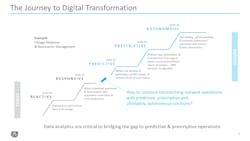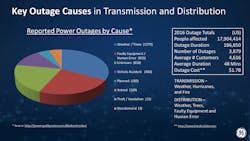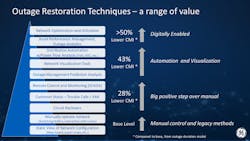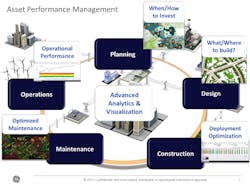Utilities that have invested in digitizing their grid have positioned themselves to reap significant rewards as a result.
As expected, a digitized grid offers radically improved visibility for monitoring and control and, thus, improved reliability and customer satisfaction. But a digital grid also offers even greater return on investment as applications are devised to take advantage of a utility’s information and communication technology (ICT) foundation and resulting data streams.
Asset performance management, or APM, is a case in point. APM refers to the strategic and business imperatives for obtaining optimal performance of grid assets across their full lifecycle, from planning, design and construction to operations and maintenance and disposal.
As a digital grid produces more data, and distributed processing, machine learning, and analytics become more powerful, leaps in APM-based prognostics and automation will eliminate many if not all unexpected equipment failures. It will enable a utility to rationally prioritize capital planning for aging asset replacement. APM applications can perform triage for storm readiness, meter analytics for hot socket detection, enable optimal energy diversion strategies for planned and unplanned outages, create voltage profiles for problematic feeders and gauge the effectiveness of vegetation management programs.
In every case, an APM output is made meaningful through the use of dashboards designed to highlight analytics-powered insights.
An enabling ICT foundation
By implementing more sophisticated sensors in greater numbers, including intelligent electronic devices (IEDs), tying them together via data networks with the appropriate response requirements, and making full use of both operational and non-operational data, digitized utilities have built a solid foundation for value creation. And new, valuable sources of data are emerging, including unmanned aerial vehicles (UAVs or “drones”), robotics and even “smart helmets” that tie field technicians to human and digital sources of guidance.
(As I strongly recommended in a T&D World op-ed, “Drones and Robots: A Data Management Opportunity,” the power industry must insist that these new data sources rely on standards and open architectures to speed time to value.¹
With APM applied to transmission, distribution and customer premise assets, the return on investment is so strong it fits the proverbial category of “no brainer.” Of course, every individual utility must build its own specific business case, which only makes sense if it has built that crucial ICT foundation.
APM business case
In a hypothetical case, however, a utility might invest, say, US$30,000, for APM-related hardware and software and pay a vendor with a cloud-based analytics service an annual fee to substantially reduce unexpected equipment failures.² What is the benefit? In the case of a substation-based power transformer failure, that means avoiding an estimated, average $3 million loss. Nearly half of that cost is attributable to business interruptions.³ If power cannot be rerouted around that suddenly non-functional substation, a utility might spend substantial sums buying power on the spot market. If a transformer fails catastrophically, it can destroy its substation, release hazardous materials into the environment and imperil human lives.
In the more calculated context of capital planning, major grid assets in developed countries are overdue for replacement. The average age of a large power transformer in the United States is 40 years and 70 percent are 25 years or older.⁴ No utility can afford to swap out its assets en masse, but must prioritize capital investments in asset upgrades. APM provides the analytics to do that. Deferring the purchase of a new $1 million transformer for two years can save $100,000 or 10 percent of the cost of the asset itself.⁵
Drivers for APM go beyond aging infrastructure and match up well with drivers for grid modernization. A documented increase in extreme weather increases the risk of sudden asset failure. And as utilities seek to reduce emissions and make the grid more sustainable they need to understand how relatively new assets behave, especially as they age.
APM’s multiple benefits
As APM’s sophistication grows, it will help address another major utility challenge: the aging, retiring workforce.
In the recent past, primitive sensors in a monitoring and diagnostics setting would be periodically tapped for data using a dial-up connection. A PC equipped with a spreadsheet program allowed seasoned professionals to exercise their best professional judgment in prioritizing the replacement of assets considered at high risk of failure. This practice has been as much art as science.
APM’s reliance on data from near-ubiquitous sensors, distributed processing, and continuous monitoring at higher speeds – all attributes, not coincidentally, of substation automation, a subset of a digitized grid – will ultimately enable automated asset failure predictions. That will ease reliance on seasoned professionals for this role; their valuable judgment will be best applied elsewhere.
Applications and Use Cases
Determining asset health through condition-based monitoring sensors and analysis presents an obvious APM value. In contrast, the APM-enabled concept of a “digital twin” for high-criticality assets such as substation transformers – that is, a digital model that mimics a specific piece of machinery – allows scenario testing to understand and predict factors that might lead to real-world asset failure.
The continuous monitoring of all physical assets in various classes such as transformers and switchgear enables APM to perform outage prediction across a fleet of assets by taking into account weather and the propensity of individual assets to fail – the two top causes of power outages in distribution systems.6 Thus an APM dashboard can, for example, depict meters and detect hot sockets in need of attention across an entire service area and present that information in readily comprehensible fashion.
Ultimately, APM-generated data and analysis contributes as well to greater accuracy in network connectivity models to improve analytic results and outcomes across operations and enterprise.
Conclusion
Increasingly, families of applications such as APM are being developed to meet utilities’ most pressing challenges – if they have built a fully functioning ICT foundation. APM has the potential to move the power industry from a costly, reactive stance towards reliability and customer satisfaction to a cost-effective, predictive, autonomous stance. This is one among many value-added outcomes that so many of us had long foreseen for grid modernization. Today, with APM, the digitized grid delivers on what was once merely a dream.
Endnotes
1 John D. McDonald, “Drones and Robots: A Data Management Opportunity,” T&D World (29 November 2017)
2 APM offerings vary by vendor.
3 According to a study by Hartford Steam Boiler Inspection & Insurance Co. and the Lawrence Berkeley National Laboratory, “An Insurance Perspective on U.S. Electric Grid Disruption Costs,” 2016. http://insurance.lbl.gov/documents/insurance-electric-grid-disruptions.pdf
4 Office of Energy Delivery and Energy Reliability, U.S. Department of Energy, “Large Power Transformers and the U.S. Electric Grid.” https://www.energy.gov/sites/prod/files/Large%20Power%20Transformer%20Study%20-%20June%202012_0.pdf
5 This is a hypothetical thumbnail sketch of likely savings. For an exegesis of the business case process, see Steve Haacke, et al., “Plan Ahead for Substation Automation,” IEEE Power and Energy magazine (March/April 2003)
6 Per Eaton BlackoutTracker, http://powerquality.eaton.com/blackouttracker/default.asp?act=smtc&id=&key=&Quest_user_id=&leadg_Q_QRequired=&site=&menu=&cx=3&x=12&y=4
About the Author
John D. McDonald
SmartGrid Business Development Leader
John D. McDonald, P.E., is Smart Grid Business Development Leader for GE’s Grid Solutions business. John has 45 years of experience in the electric utility industry. John joined GE on December 3, 2007 as General Manager, Marketing for GE Energy’s Transmission and Distribution business. In 2010 John accepted the new role of Director, Technical Strategy and Policy Development for GE Digital Energy. In January 2016 John assumed his present role with the integration of Alstom Grid and GE Digital Energy to form GE Grid Solutions.
John was elected to the Board of Governors of the IEEE-SA (Standards Association), focusing on long term IEEE Smart Grid standards strategy. John was the Chair of the Smart Grid Interoperability Panel (SGIP) Governing Board for 2010-2015 (end of 1Q) coordinating Smart Grid standards development in the US and global harmonization of the standards. John is a member of the NIST Smart Grid Advisory Committee and Chair of its Technical Subcommittee.
John is Past President of the IEEE Power & Energy Society (PES), Finance Committee Chair of the Smart Energy Consumer Collaborative (SECC) Board, the VP for Technical Activities for the US National Committee (USNC) of CIGRE, and the Past Chair of the IEEE PES Substations Committee. He was on the IEEE Board of Directors as the IEEE Division VII Director. John is a member of the Advisory Committee for the annual DistribuTECH Conference, on the Board of Directors and Executive Committee of the GridWise Alliance and Finance Chair, Vice Chair of the Texas A&M University Smart Grid Center Advisory Board, and member of the Purdue University Strategic Research Advisory Council. John received the 2009 Outstanding Electrical and Computer Engineer Award from Purdue University.
John teaches a Smart Grid course at the Georgia Institute of Technology, a Smart Grid course for GE, and substation automation, distribution SCADA and communications courses for various IEEE PES local chapters as an IEEE PES Distinguished Lecturer (since 1999). John has published 100 papers and articles in the areas of SCADA, SCADA/EMS, SCADA/DMS and communications, and is a registered Professional Engineer (Electrical) in California, Pennsylvania and Georgia.
John received his B.S.E.E. and M.S.E.E. (Power Engineering) degrees from Purdue University, and an M.B.A. (Finance) degree from the University of California-Berkeley. John is a member of Eta Kappa Nu (Electrical Engineering Honorary) and Tau Beta Pi (Engineering Honorary), a Life Fellow of IEEE (member for 48 years), and was awarded the IEEE Millennium Medal in 2000, the IEEE PES Excellence in Power Distribution Engineering Award in 2002, the IEEE PES Substations Committee Distinguished Service Award in 2003, the IEEE PES Meritorious Service Award in 2015, the 2015 CIGRE Distinguished Member Award and the 2015 CIGRE USNC Attwood Associate Award.
John has co-authored five books and has one US Patent: Automating a Distribution Cooperative from A to Z: A Primer on Employing Technology (National Rural Electric Cooperative Association – 1999); Electric Power Substations Engineering (Third Edition) (CRC Press – 2012); Power System SCADA and Smart Grids (CRC Press – 2015); Big Data Application in Power Systems (Elsevier - 2017); Smart Grids: Advanced Technologies and Solutions (Second Edition) (CRC Press – 2018); and US Patent (9,853,448) on Systems and Methods for Coordinating Electrical Network Optimization (December 26, 2017).





